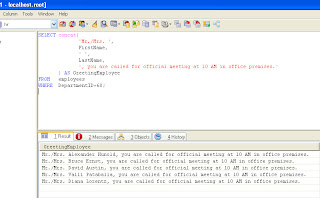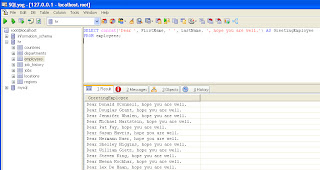In concatenations of two different datatypes, Oracle Database returns the datatype that in a lossless conversion. Therefore, if one of the arguments is a LOB, then the returned value is a LOB. If one of the arguments is a national datatype, then the returned value is a national datatype. In Oracle , the CONCAT function will only allow you to concatenate two values together.
Oracle provides the CONCAT character function as an alternative to the vertical bar operator for cases when it is difficult or impossible to control translation performed by operating system or network utilities.

Use this function in applications that will be moved between environments with differing character sets. Oracle CONCAT function : The Oracle CONCAT () function returns the result (a string) of concatenating two string values. SQL HOME SQL Intro SQL Syntax SQL Select SQL Select Distinct SQL Where SQL An Or, Not SQL Order By SQL Insert Into SQL Null Values SQL Update SQL Delete SQL Select Top SQL Min and Max SQL Count, Avg, Sum SQL Like SQL Wildcards SQL In SQL Between SQL Aliases SQL Joins SQL Inner Join SQL Left Join SQL Right Join SQL Full Join SQL Self Join SQL. Learn more about the CONCAT function in this article. Purpose of the Oracle CONCAT Function.
It’s part of standard string manipulation in many programming languages. For future reference, StackOverflow is a massive repository of previously answered questions. Browse other questions tagged sql oracle concatenation concat or ask your own question.

Blog Research update: Improving the question-asking experience. Noted that the Oracle CONCAT () function concatenates two strings only. The CONCAT () function accepts two arguments whose data types can by any of the data types CHAR, VARCHAR NCHAR, NVARCHAR CLOB, or NCLOB.
This tutorial is based on examples so it would be easier to understand. Oracle Concat Function allows to merge or unite two strings and the following data types can used CHAR, VARCHAR NCHAR, NVARCHAR CLOB, or NCLOB. The function has two input parameters and it returns only one string. Dans le langage SQL la fonction CONCAT() permet de concaténer les valeur de plusieurs colonnes pour ne former qu’une seule chaîne de caractère.
Cette fonction SQL peut se révéler pratique pour mettre bout-à-bout les valeurs de plusieurs colonnes pour n’en afficher qu’une. For older linked servers, the CONCAT operation will happen locally, after the linked server returns the non-concatenated values. In SQL Server, you can concatenate two or more strings by using the T-SQL CONCAT() function. In SQL Server (and in any computer programming environment), string concatenation is the operation of joining character strings end-to-end.
SQL CONCAT Function is used to Concatenate (combine) or more strings. How to Concatenate Strings in SQL. Webucator provides instructor-led training to students throughout the US and Canada. We have trained over 90students from over 10organizations on technologies such as Microsoft ASP. Get the Complete Oracle SQL Tuning Information The landmark book Advanced Oracle SQL Tuning The Definitive Reference is filled with valuable information on Oracle SQL Tuning.
This book includes scripts and tools to hypercharge Oracle 11g performance and you can buy it for off directly from the publisher.

Bei älteren Verbindungsservern wird der CONCAT-Vorgang lokal ausgeführt, nachdem die nicht verketteten Werte vom Verbindungsserver zurückgegeben wurden. MySQL has the CONCAT () function, which allows you to concatenate two or more strings. In MySQL (and in any computer programming environment), string concatenation is the operation of joining character strings end-to-end.
If this concerns you, use a User-Defined Aggregate Function described below. What are the technical differences between WM_ CONCAT vs LISTAGG? I know WM_ CONCAT is undocumented function. How do you refine out to a certain format in a SQL string. MySQL has a nice aggregate function called GROUP_ CONCAT , which concatenates all strings in a group in given order, separating them with a given separator.
In one of the previous articles, I wrote about emulating this function in PostgreSQL. The above syntax concatenates str str str and any other strings together. Each str can be a column name, or it can be a literal character string (meaning a sequence of characters enclosed by two single quotes), or just white space.
Brak komentarzy:
Prześlij komentarz
Uwaga: tylko uczestnik tego bloga może przesyłać komentarze.